Soft, silken, creamy Egg Tofu made with eggs and dashi. It is steamed, chilled, then served with savory dashi broth. Enjoy the refreshing flavors while it quickly melts away in your mouth.
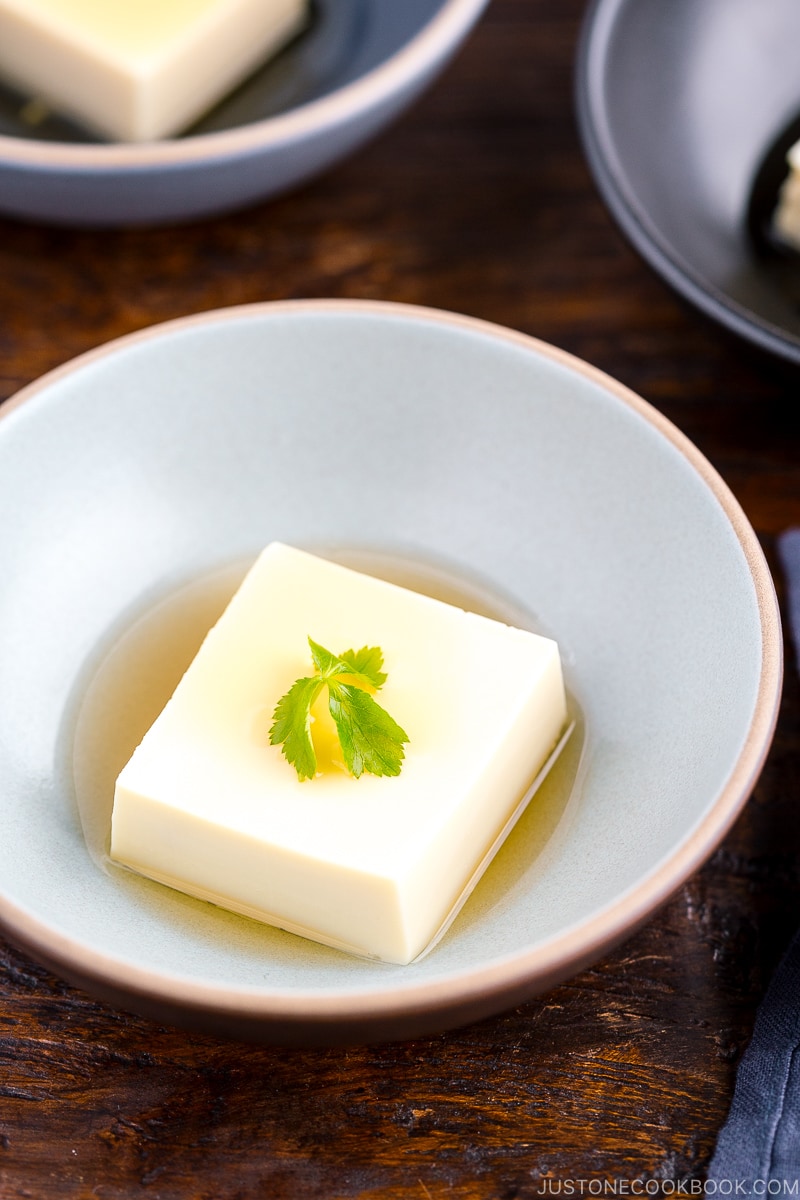
The popular Japanese TV program called Shinya Shokudo (深夜食堂) or ’Midnight Diner: Tokyo Stories (Season 1)‘ is now available on Netflix. The show features Japanese diner/home cooking recipes that are not your standard Japanese food served in restaurants in the U.S.
Since the drama doesn’t provide detailed ingredients and step-by-step instructions, I’ll be sharing these copycat recipes on my blog. Today’s recipe is Egg Tofu (玉子豆腐).
What is Egg Tofu?
Egg Tofu is Japanese steamed tofu made of eggs and dashi mixture that is steamed till firm, chilled, then served with a dashi and soy sauce broth. In Japan, we call this dish Tamago Dofu (玉子豆腐).
Even though it’s called “tofu”, egg tofu does not include soybeans or nigari. What is nigari? It is magnesium chloride which is used to firm soymilk into silken tofu. The dish is called egg tofu because of its tofu-like texture and square shape, just like Sesame Tofu (胡麻豆腐) and Almond Tofu (杏仁豆腐) which also do not contain soy.
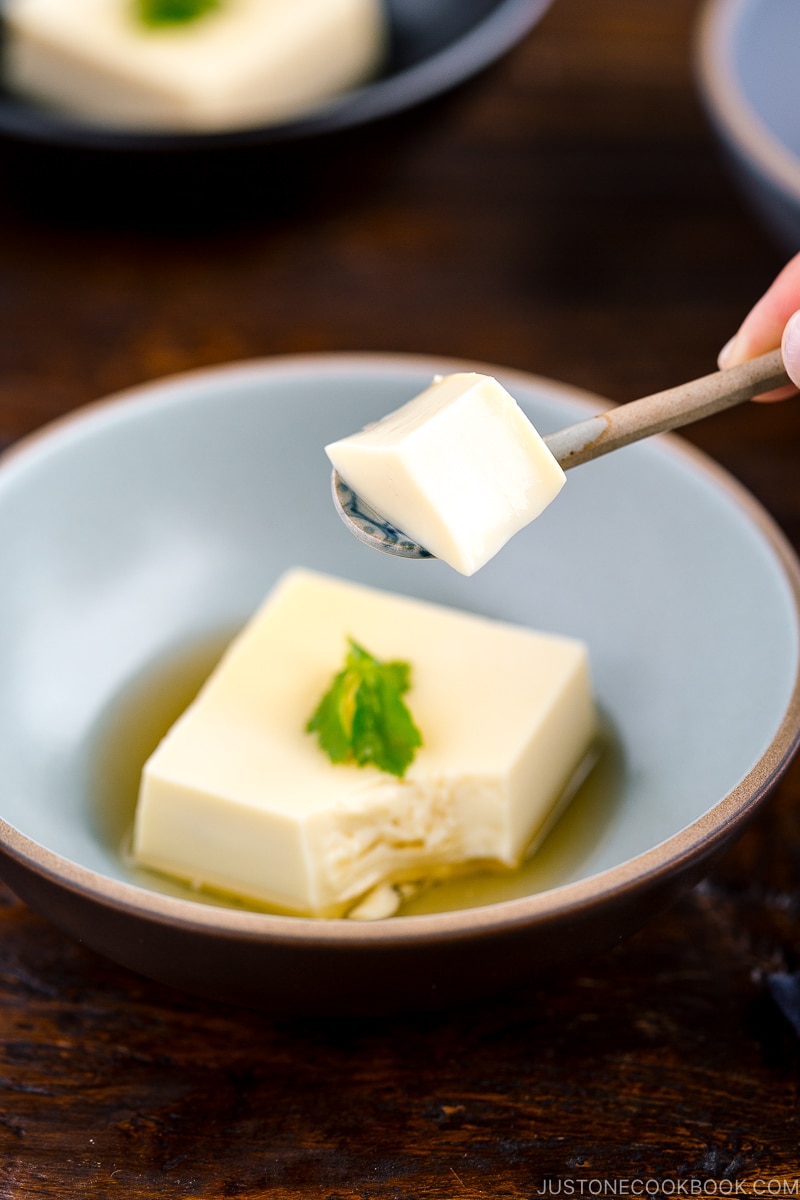
Tips for Making Egg Tofu
1. Egg to Dashi Ratio
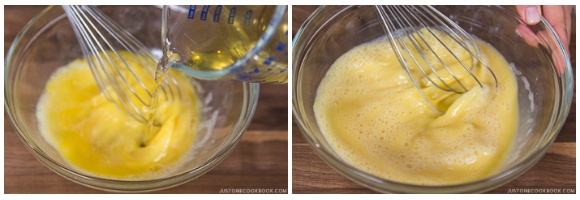
Usually, egg to dashi radio is one to 1.5 – 2. If I use 4 eggs (roughly 200 grams; American large egg is about 50 grams each without shell), you’ll need 300 – 400 grams/ml dashi to achieve smooth, silky texture of egg tofu. The higher the dashi texture is in the egg mixture, the silkier it gets.
2. Usukuchi Soy Sauce vs. Regular Koikuchi Soy Sauce
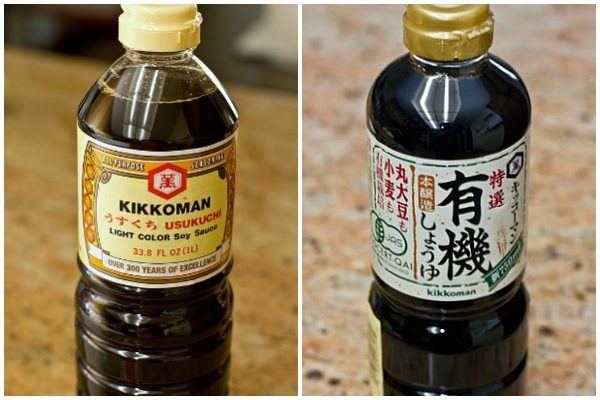
Usukuchi soy sauce (薄口醤油) is a light-color soy sauce, which actually tastes saltier than regular, darker color koikuuchi soy sauce (See my pantry page).
I have to admit I don’t always keep usukuchi soy sauce in my kitchen. Remember my recent Kazunoko (Herring Roe) recipe for New Year’s feast? That would have been lighter in color if I have used usukuchi soy sauce instead of regular soy sauce.
Usukuchi soy sauce is more commonly used in western Japan, such as Osaka. As I grew up in Yokohama (near Tokyo), I’m used to using dark-colored broth in my udon noodle soup made with regular soy sauce. Regular koikuchi soy sauce is also more common and available to purchase everywhere.
However, with dishes that you want to maintain the ingredients’ natural color, I highly recommend usukuchi soy sauce. For example, when you make egg tofu and chawanmushi (savory steamed egg custard), you want to keep a light and creamy yellow color. So you would use usukuchi soy sauce to keep this appetizing beautiful color with light-color soy sauce.
So, may I encourage you to get usukuchi soy sauce?
3. Steaming Egg Tofu to Perfection
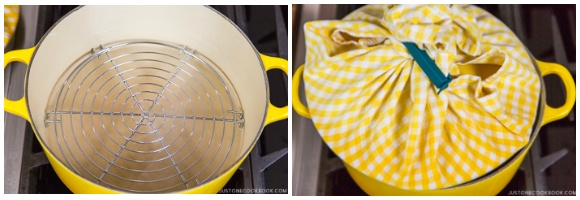
Even though “steaming” is a fairly simple cooking method, when you cook egg tofu, you can’t just put the food in the steamer, cover, and wait till it’s done. If you do this, the temperature in the pot could be too hot and you will overcook the egg tofu.
The pot can’t have too much steam (resulting in high temperature), as it will lead to the protein being hardened and solidified. You can still eat it, but it will result in tiny holes on the inside and the surface of the egg tofu. In Japanese, we call this “Su ga tatsu (すが立つ)”.
To avoid this unpleasant texture in tofu from happening, you have to make sure the pot is not too hot. You can easily do this by leaving the lid ajar and reducing the heat to the lowest possible, making sure that inside the steamer is less than 194F (90C). The trick for this dish is to cook slowly on low heat.
Make sure to cover the lid with a large kitchen towel so condensation won’t drop and ruin your egg tofu. I also figured out a new trick. It was a bit harder to take it out the hot stainless steel Nagashikan (ramekin). If you place the cloth underneath and sides, you can easily pull up using the cloth. This also prevents the stainless steel from getting too hot on the bottom.
As my bamboo steamer didn’t have enough height for my egg tofu ramekin to go inside, I used a 5 1/2 QT Le Creuset Dutch oven and a 8 5/8″ round cooling rack as a steamer.
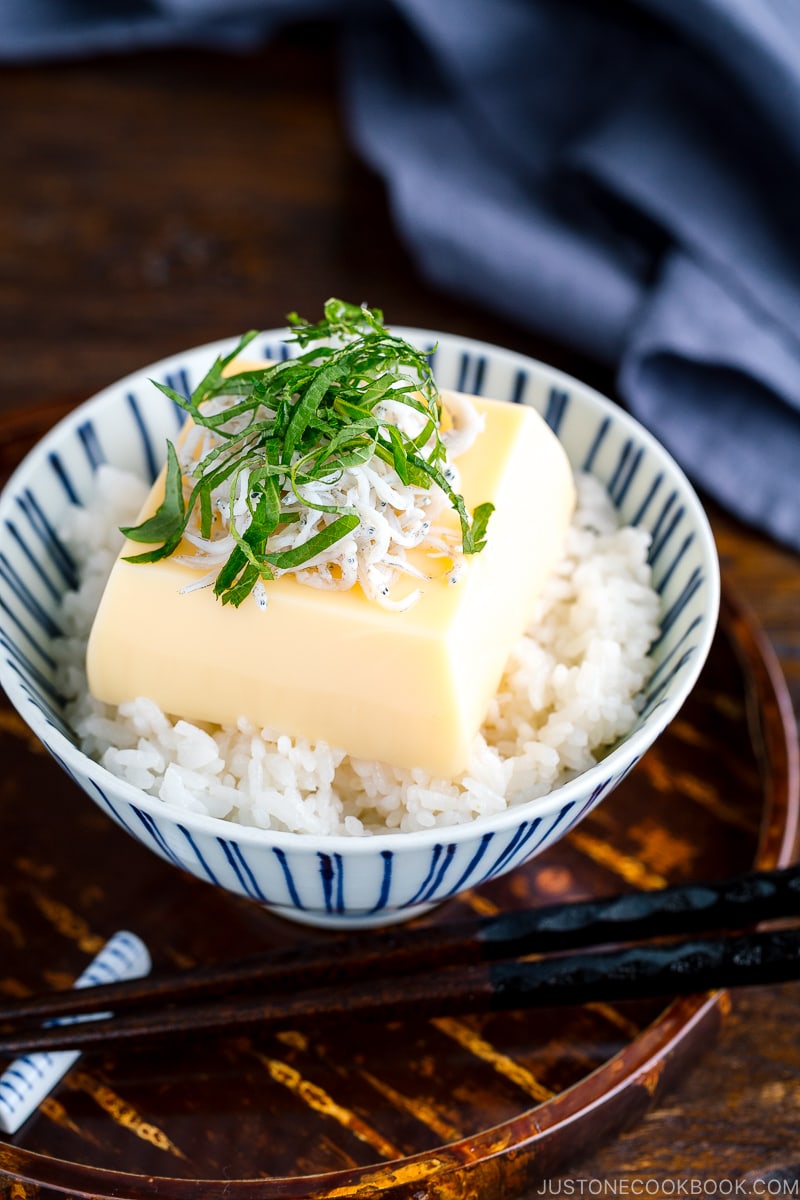
How To Make ‘Midnight Diner’ Egg Tofu on Rice
In Episode 5 of ‘Midnight Diner: Tokyo Stories” Season 1, the egg tofu is served on steamed rice. I’ve never tried eating egg tofu over rice, so I attempted after watching this episode. To my surprise, it was very delicious and so easy to make! Here are the main ingredients:
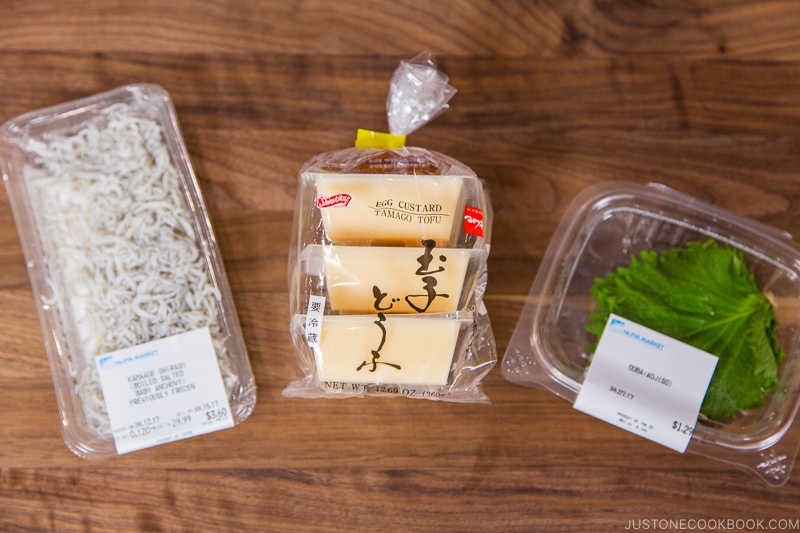
From left, kamaage shirasu (boiled baby sardines), egg tofu, and shiso leaves. For making egg tofu from scratch, follow today’s recipe below.
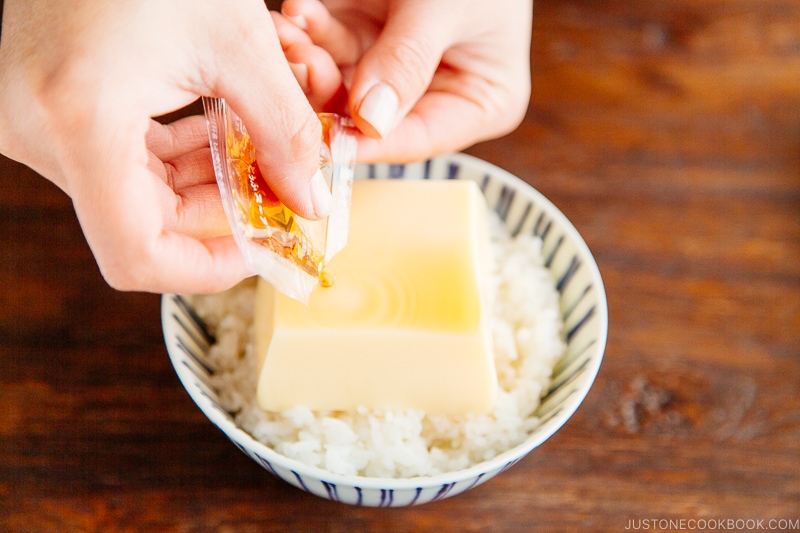
Serve steamed rice in your rice bowl and place the egg tofu on top. Pour the sauce that comes with the egg tofu package (or homemade sauce I provided in today’s recipe). Then place the shirasu (no need to rinse) and shiso on top. And that’s it!
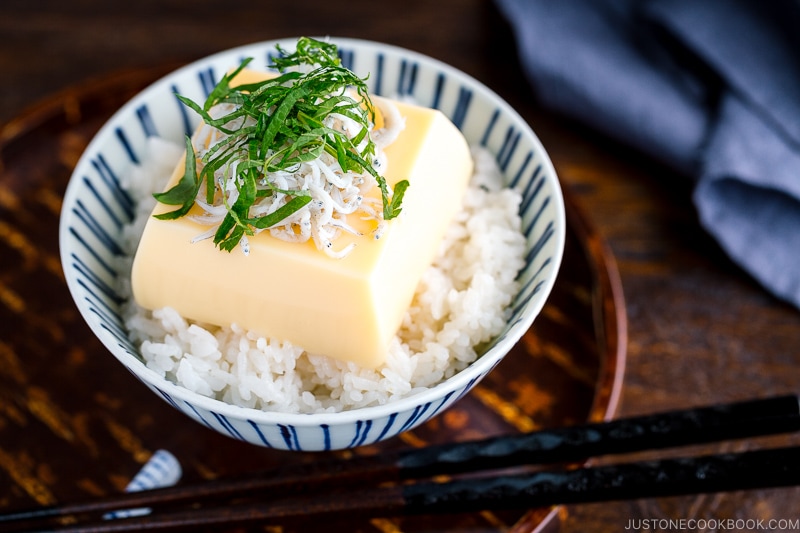
Delicious Egg Tofu on Rice, just like the one you saw in ‘Midnight Diner’. This humble dish really surprised us. Personally, I was surprised how the saltiness from shirasu and refreshing shiso flavor worked so well together in this recipe.
As shirasu and shiso are unique ingredients and often hard to find outside of Japan, you may eat egg tofu on rice by itself or enjoy egg tofu as an appetizer. The dashi poured over the egg tofu is really delicious, so you will enjoy this dish either way.
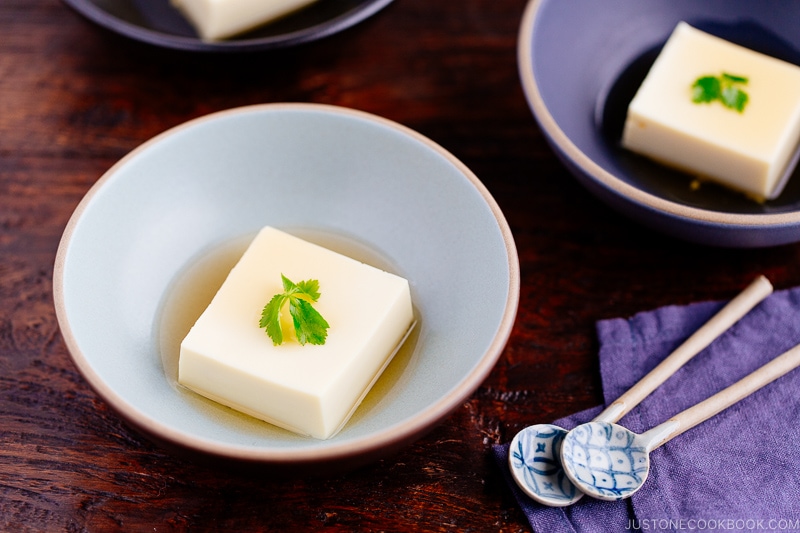
Sign up for the free newsletter delivered to your inbox and stay in touch with me on Facebook, Pinterest, YouTube, and Instagram for all the latest updates.
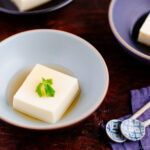
Egg Tofu (Tamago Tofu)
Ingredients
- 4 large eggs (50 g each w/o shell)
- 1¼ cups dashi (Japanese soup stock) (use standard Awase Dashi, dashi packet or powder, or Vegan Dashi)
- 2 tsp usukuchi (light-colored) soy sauce
- ⅛ tsp Diamond Crystal kosher salt
For the Sauce
- 2 Tbsp mirin
- 150 ml dashi (Japanese soup stock) (⅔ cup minus 2 tsp)
- 1 Tbsp usukuchi (light-colored) soy sauce
For the Toppings
- mitsuba (Japanese parsley) (optional)
Instructions
- Before you start: Please note that this is a chilled dish and requires at least 2 hours of chilling time, preferably overnight.Gather all the ingredients. Set up a steamer with water in the pot. Bring it to a boil, then turn off the heat and keep the lid on. I use a nagashikan (egg tofu ramekin). You can buy it on Amazon (finally they have one!) You can also use a square/rectangular container or individual bowl such as chawanmushi cups.
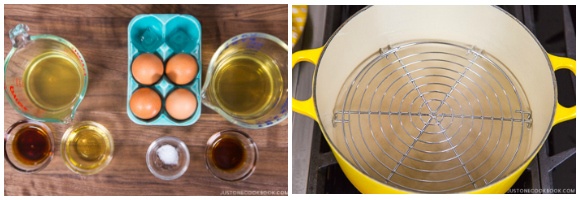
To Make the Sauce
- In a small saucepan, bring 2 Tbsp mirin to a boil and let the alcohol evaporate. When the alcohol smell disappears (after 10–15 seconds), add 150 ml dashi (Japanese soup stock) (⅔ cup minus 2 tsp).
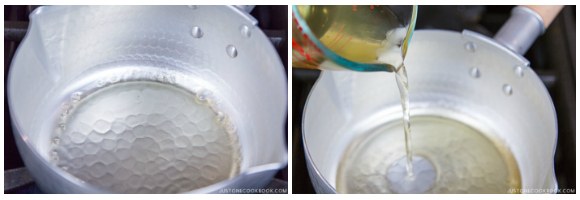
- Add 1 Tbsp usukuchi (light-colored) soy sauce and bring it to a boil. Once it‘s boiling, turn off the heat and set aside.
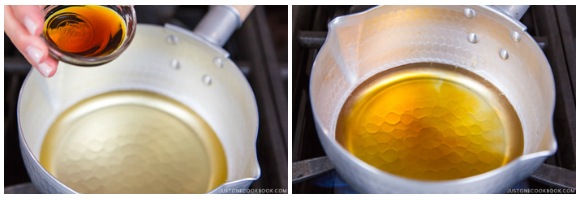
To Make the Egg Tofu
- Crack 4 large eggs (50 g each w/o shell) into a bowl and whisk well. Add 2 tsp usukuchi (light-colored) soy sauce, ⅛ tsp Diamond Crystal kosher salt, and 1¼ cups dashi (Japanese soup stock).
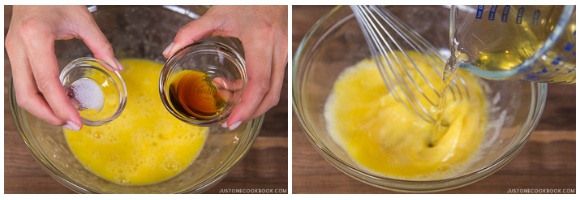
- Strain the egg mixture through a fine-mesh sieve to achieve a silky, fine texture. I believe this step makes a huge difference in the final result.
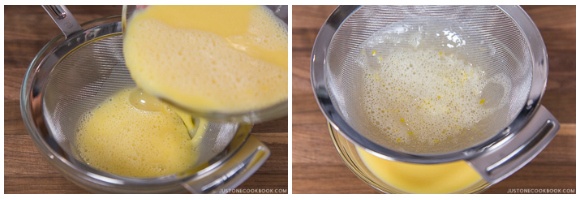
- Quickly rinse the nagashikan or ramekin under cold running water. Pour the egg mixture into it.
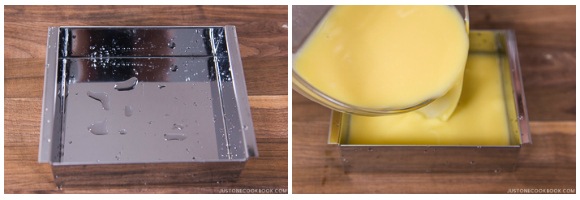
- Scoop away the small bubbles on the surface with a spoon. Place the nagashikan or ramekin on a steamer* rack. Tip: After trying this recipe a few more times, I figured out a new trick. It was a bit difficult to remove the hot stainless steel nagashikan from the steamer. However, if you line the bottom and sides of the steamer with a cotton cloth, you can easily use it to pull up the egg tofu ramekin. This also prevents overheating the bottom of the nagashikan from the heat beneath. * As my bamboo steamer didn‘t have enough height for my egg tofu ramekin to go inside, I used a 5½ QT Le Creuset Dutch oven and an 8⅝" round cooling rack as a steamer.
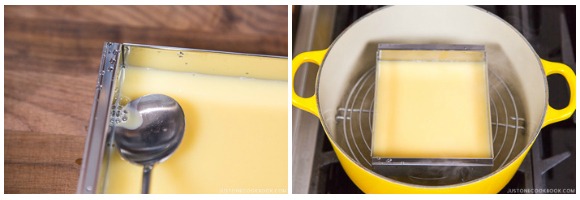
- Close the lid wrapped with a large kitchen towel; otherwise, the condensation collecting on the lid will drop onto your Tamago Tofu and ruin it. Leave the lid slightly ajar so it won't get super hot inside the pot but just hot. Steam on the lowest heat possible on the stove for 20 minutes, or until a skewer inserted comes out clean.
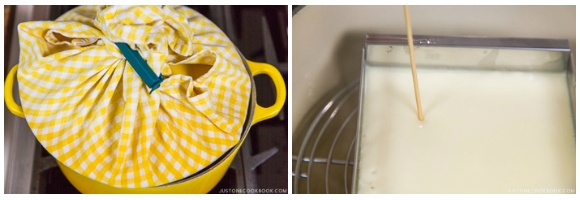
- Once it’s done, take the ramekin or nagashikan out of the steamer immediately. Let it cool completely on the countertop and chill in the refrigerator for 2 hours. If you plan to serve immediately, place the nagashikan in an ice water bath to cool.
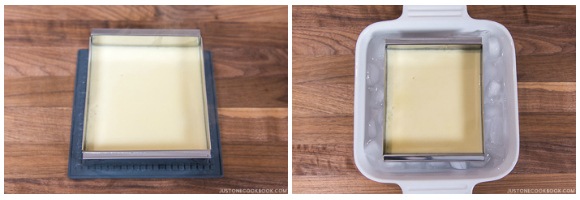
- Run the knife along the edges of the nagashikan and slide out the Tamago Tofu.

- Cut into 4 to 6 pieces. Transfer to a serving plate/bowl. Pour the sauce and garnish with mitsuba (Japanese parsley) (if using).
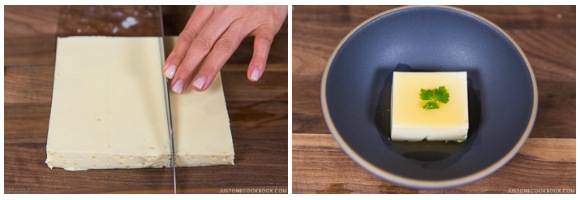
To Store
- Store in the refrigerator for up to 2 days. You can‘t freeze Tamago Tofu as the texture will change.
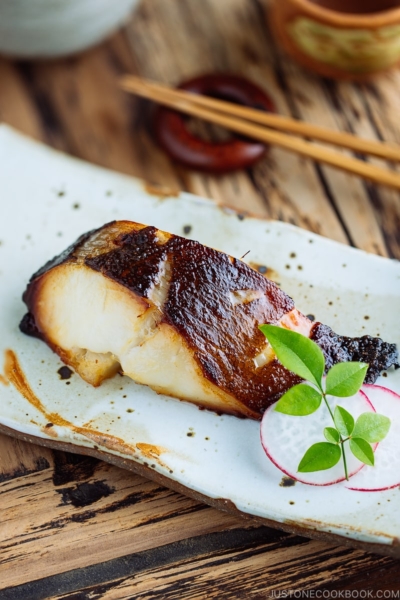
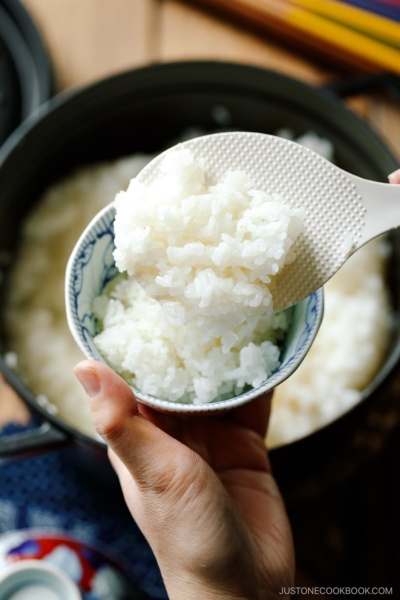
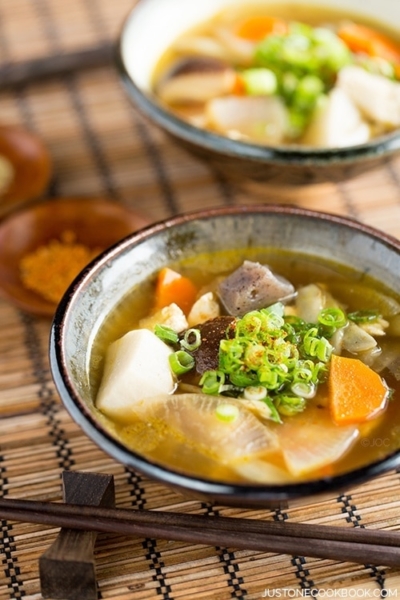
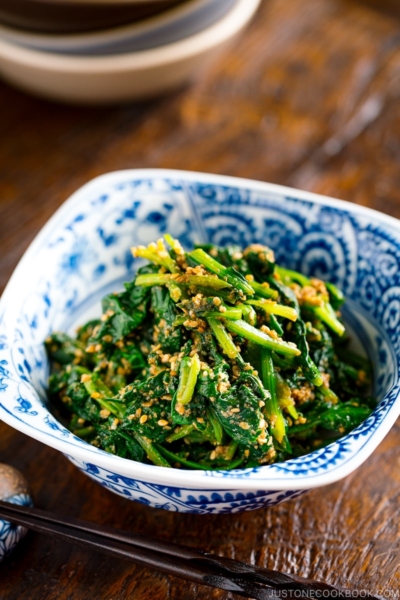




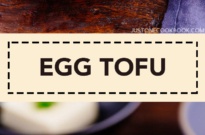
I am wondering if this would work in a silicone mold instead of the metal nagashikan? Would you adjust the cook time at all? I think I will try it in some of my silicone molds and see how it turns out. If I can make small versions of this I can add them to my bento box!
Hi Holly! I don’t own a silicone mold so I can’t tell. 🙁 Sorry… I wonder if it’s easier to invert the egg tofu with a silicone mold. Please keep us posted!
Another amazing recipe!!! I wanted to take a photo but it literally disappeared after it was cooled down. Thank you again Nami-san!!! Luc
Hi Luc! Awesome! So happy to hear yours came out well! Thank you for trying this recipe and for your kind feedback. xo
I wonder if it might be easier (though less traditional) to bake the custard in a low oven in a water bath like creme caramel or creme brûlée?
Hi Neil! I think you can as long as you keep it covered somehow. It’s the steaming you need, and you can do that with oven too if you can set up correctly. 🙂
Cool! I’m a big fan of chawanmushi, but never seen this. Now I gotta find a Nagashikan. Any recommendations in San Francisco?
Hi Ryan! I got the Nagashikan from here:
https://toirokitchen.com/collections/kitchen-tools
I actually have a question for you. I noticed that my copyrighted images are on the site you link in your profile and my watermark on the images are all cut off probably because of the image size, not intentionally done.
For example, this one: https://craftlog.com/us/cooking/gyoza-3kzX4
Then, when I click on each “You may also like” links, it links to each recipe with MY copyrighted image and ingredient list shown (the instruction part links to my website).
I can’t let my copyrighted images taken away from my site, not just one or two, but A LOT OF THEM.
Please remove them immediately. I really work hard to create my site, taking each pictures, and I do not want Google to relate my images with this site.
If you don’t take down immediately, I have to file DMCA for copyright infringement. I’m so sorry, but I really have no choice…
I am assuming that you didn’t mean any harm, but this hurts my website’s SEO.
I hope you understand…
HI …for this egg tofu the total cook time is stated as 2hours 35min. But the prep and cook time does not equal this. Am i missing something?
Hi Judy! Thanks for bringing it to my attention. I edited my step, so it’s less confusing. Step 6: Once it’s done, take out from the steamer immediately and let cool on the counter top and chill in the refrigerator for 2 hours. If you plan to serve immediately, place the Nagashikan in the ice water to cool.
I just started watching this show on Netflix and always look up the food featured in each episode afterwards. So interesting to learn more about Japanese home/comfort food, thanks for posting!
Hi Delia! I’m happy to hear you started watching this show! I hope new Midnight Diner fans will find my recipe online. 😀 I’ll be covering all the recipes in Season 1. I hope you try making these recipes at home! xo
Cook tamago tofu a second time it not as good as 1st time because I steam it a bit too long because after 20 mins the tofu is not set completely.
As you reply to my question last week you right the tofu color depend on the egg yolk color light or orangery. That’s why mine tofu don’t turn out as white as yours
However my grandchildren love it.
Hi Margaret! Thank you for your feedback. I’m so happy to hear your grandchildren enjoyed it. 🙂
I did your tahu recipe follow all ingredients given but my tahu is yellowish in color. Instead of pure white as shown in your website. Otherwise all turn out well have not taste yet.
Hi Margaret! Could it be the difference in our egg color (I think American eggs are not as orange/dark yellow color like ones in Japan). Or dashi color, or maybe amount of soy sauce? It has to be from the ingredients, I think…
Thank you for the Egg Tofu recipe. We enjoyed watching the Midnight Diner series on Netflix. The episode which featured the little boy eating the egg tofu looked so delicious, it made me want to try it. With your recipe, I’ll be sure to try it. Thank you.
Hi Amy! Yeah the poor boy, but happy to see he likes this simple but delicious dish! I had never tried tamago dofu on top of rice, so it was fun for me to try! Hope you enjoy yours too!
this looks tasty, i’ll have to try it soon! what are the dimensions of your nagashikan?
Hi Thyna! Here’s the dimension: W15 cm x D13.5 cm x H4.5 cm (W6″ x D5.25 x H1.75″). I got one from the site that I put in my Recipe Notes. 🙂
OMG! “Midnight diner” is shown on Netflix?!!! Now I don´t have any excuse NOT to subcribe. 😀
And I hope you continue showing the recipes of the series.
Thank s lot! <3
Hi Thao! Yeah, pretty exciting! I heard about this show for a long time and finally watched it. Can’t wait for Season 2! Thanks for reading my post!
We love Midnight Diner! 😀 I learned about your blog searching for a recipe for a dish I learned about on that show. I can’t wait for season 2 to start.
Hi Richard! REALLY! You found my blog when you were looking for midnight diner recipe!!! I’m so happy. I was hoping to get new visitors like you from searching the show’s recipe! Me too, I can’t wait for Season 2!
I really liked episode 9, the hamakatsu episode. is a how-to demonstration video for this nice dish in our future? BTW, I made your nama chocolate recipe for my sweetheart for Valentine’s day and it was a perfect success. Thank you. I’m going to try the green tea version tomorrow on my day off from work.
Hi Richard! Yes I’m planning on it. So far we finished 5 recipes including this. 🙂 We made videos for some.
And oh my I’m SUPER happy to hear you made Nama Chocolate and came out success!!!! Thank you for your kind feedback, and hope you two had a wonderful V-day.
Enjoy Green Tea version too! xo 🙂
Ooo I loved watching this drama! There’s also a movie by the way.
Is the egg tofu the same as the one in the below link?
http://www.noobcook.com/egg-tofu/
Hi Jessica! I need to check the movie (I’m not sure if it’s available here in the U.S.).
I have never seen/tried that in the package. From the description, it’s not clear that it’s made of soybean or not. I assume it’s similar? Japanese one doesn’t contain soybean at all. Just egg and dashi. 🙂
It looks very much like chawan mushi.The ingredients are all d same except that it is chilled.Chawan mushi must be eaten hot so that it’s soft n silky.Here for egg tofu you said got to chill 1st. Will that mean that d egg tofu will not be soft already when eaten?
Hi Tina! Yes, we consider chawanmushi is a hot version, and egg tofu is a chilled version.
Chawanmushi will be STILL soft and silky even though you don’t eat it hot. Chawanmushi is always served hot. Egg tofu is almost always chilled (or at least cool).
The texture will be the same (well, precisely, it depends on the dashi amount, but I’d say it’s “similar”). While chawanmushi has more ingredients inside the egg custard, we usually eat egg tofu plain.
Thanks for lovely recipe! I love this drama too! And i love steam egg..^_^ Hope i make the egg to turn out as good as yours~
Hi Debbie! Happy to hear you like the drama too. 🙂 I can’t wait to watch Season 2. Thanks for reading my post!